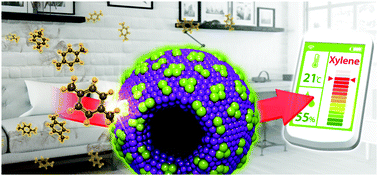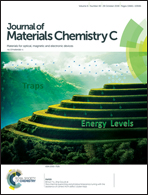Hollow spheres of CoCr2O4–Cr2O3 mixed oxides with nanoscale heterojunctions for exclusive detection of indoor xylene†
Abstract
As an effective alternative to simple binary oxide chemiresistors, polynary oxides with excellent tunability of the composition and hetero-interfaces are considered as promising material platforms for designing highly selective and sensitive gas sensors. In this study, ternary spinel CoCr2O4 hollow spheres and CoCr2O4–Cr2O3 mixed oxide hollow spheres were prepared via one-pot ultrasonic spray pyrolysis using solutions with different cation compositions (i.e., [Cr]/[Co] = 2, 3, and 4), and their gas-sensing characteristics were investigated. The pure CoCr2O4 hollow spheres exhibited an unusually high response to 5 parts per million (ppm) of p-xylene (ratio of resistance to gas and air = 61.4), with negligible cross-responses to 5 ppm of ethanol, toluene, benzene, trimethylamine, ammonia, formaldehyde, and carbon monoxide. When CoCr2O4–Cr2O3 hollow spheres with discrete Cr2O3 nanoclusters were formed using a spray solution with a [Cr]/[Co] ratio of 3, the xylene response was enhanced to 144.1, which allows the sensitive and selective detection of sub-ppm level p-xylene. The unprecedentedly high xylene selectivity and response in the present study are explained by the gas-accessible hollow morphology, the unique catalytic activity of the ternary and mixed oxides, and the enhanced chemiresistivity due to the formation of a heterojunction between CoCr2O4 and Cr2O3. The novel ternary oxide-based gas sensors with excellent xylene-sensing performance can be used in indoor air-monitoring applications.



 Please wait while we load your content...
Please wait while we load your content...